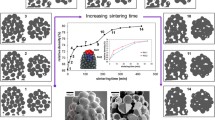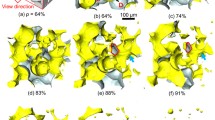Abstract
The common theoretical model used to describe the sintering process is the two particle model. This model describes comprehensively the growth of inter-particle contacts driven by the Laplace pressure. In three dimensions this model fails as cooperative material transport (i.e., movements of powder particles) occurs. The fundamental understanding of these processes is still rather sketchy and is derived from the observation of 1D or 2D samples. To observe and quantify cooperative material transport new experimental methods are needed, for example high resolution computer tomography in conjunction with photogrammetric image analysis. Single-crystal copper spheres were marked by drilling holes into the surface of each particle and two samples were prepared using the marked powder. One sample was heated continuously to 1,050 °C in a silica capillary and was analyzed by in situ synchrotron computer tomography (SCT) at the European synchrotron radiation facility in Grenoble. Free sintering was investigated by ex-situ SCT at Bessy II in Berlin. The novel technique of drilling holes into the sphere surfaces allows for the quantification of both intrinsic rotations and particle rolling by photogrammetry. The observed intrinsic rotations exceed the rolling by far and we conclude that the anisotropy of grain boundary energies results in grain boundary sliding. Furthermore, we present first computer simulations of sintering processes based on initial particle positions measured by SCT.










Similar content being viewed by others
Notes
The occurrence of such thin gaps is unlikely and metrological inaccessible. Hence must be accepted. The low probability insures a low statistical significance.
References
German RM (1996) Sintering theory and practice. Wiley, New York
Schatt W, Wieters K-P, Kieback B (2007) Pulvermetallurgie: technologien und werkstoffe. Springer, New York
German RM (2005) Powder metallurgy and particulate materials processing. Metal Powder Industries Federation, Princeton
Exner HE and Kraft T (1998) Review on computer simulations of sintering processes. In: Proceedings of powder metallurgy world congress, Granada (Spain), vol 2. European Powder Metallurgy Association, Shrewsbury, pp 278–283
Exner HE (1979) Rev Powder Met Phys Ceram 1:7
Schatt W (1992) Sintervorgänge. VDI-Verlag, Düsseldorf
Geguzin JE (1973) Physik des Sinterns. VEB Deutscher Verlag für Grundstoffindustrie, Leipzig
German RM (1994) Powder metallurgy science, 2nd edn. Metal Powder Industries Federation, Princeton
Mykura H (1979) Acta Metall 27:243
Wieters K-P, Boiko IJ, Schatt W (1984) Cryst Res Technol 19:1195
Pond RC, Smith DA (1977) Scripta Metall 11:77
Chan SW, Balluffi RW (1986) Acta Metall 34:2191
Weiser MW, De Jonghe LC (1986) J Am Ceram Soc 69:822
Exner HE, Müller C (2009) J Am Ceram Soc 92:1384
Skorokhod VV (1999) Powder Metall Metal Ceram 38:350
Eloff PC, Lenel FV (1971) The effects of mechanical constraints upon the early stages of sintering. Modern developments in powder metallurgy, vol 4. In: Proceedings of the international powder metallurgy conference. Plenum, New York, pp 291–302
Petzow G, Exner HE (1976) Z Metallkde 67:611
Sutton AP, Balluffi RW (2003) Interfaces in crystalline materials. Oxford University Press, New York
Petzow G, Exner HE (1976) Z Metallkd 67:611
Bernard D, Gendron D, Heintz J-M, Bordère S, Etourneau J (2005) Acta Mater 53:121
Vagnon A et al (2008) Acta Mater 56:1084
Lame O, Bellet D, Di Michiel M, Bouvard D (2003) Nucl Instrum Methods Phys Res B 200:287
Lame O, Bellet D, Di Michiel M, Bouvard D (2004) Acta Mater 52:977
Nöthe M, Schulze M, Grupp R, Kieback B, Haibel A (2007) Mater Sci For 539–543:2657
Grupp R, Nöthe M, Kieback B, Banhart J (2011) Nat Commun 2:298
Sauerwald F, Holub L (1933) Z Elektrochem Angew Phys Chem 39:750
Wolf D (1990) J Mater Res 5:1708
Riedel H, Zipse H, Svoboda J (1994) Acta Metall 42:445
Verlet L (1967) Phys Rev 159:98
Henrich B, Wonisch A, Kraft T, Moseler M, Riedel H (2007) Acta Mater 55:753
Swinkels FB, Ashby MF (1981) Acta Metall 29:259
Acknowledgements
The authors would like to thank the Deutsche Forschungsgemeinschaft (DFG) for funding of our research. In addition we would like to thank the Helmholtz Gemeinschaft for funding of the Virtual Institute “Photon and Neutron Research on Advanced Engineering Materials,” H. Riesemeier for the support at the BAMLine and Ecka Granulates for supplying copper powder. We are grateful to the European Synchrotron Radiation Facility for the provision of synchrotron radiation facilities and especially M. Di Michiel for his assistance in using beamline ID15A.
Author information
Authors and Affiliations
Corresponding author
Rights and permissions
About this article
Cite this article
Kieback, B., Noethe, M., Grupp, R. et al. Analysis of particle rolling and intrinsic rotations in copper powder during sintering. J Mater Sci 47, 7047–7055 (2012). https://doi.org/10.1007/s10853-012-6558-0
Received:
Accepted:
Published:
Issue Date:
DOI: https://doi.org/10.1007/s10853-012-6558-0




